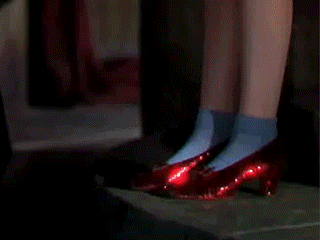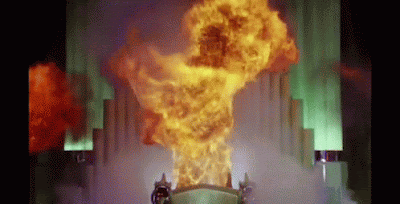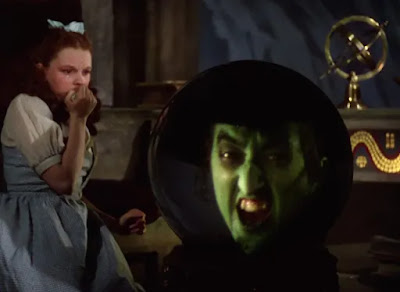The Wizard of Oz (Victor Fleming, Richard Thorpe, Mervyn LeRoy, George Cukor, Norman Taurog, King Vidor, 1939) It was designed to be M-G-M's "prestige" picture of 1939—a concept inspired by Irving Thalberg as a production intended to show off the studio at its best, rather than to turn a profit.
Those aspects would be creative, as far as music and dance numbers (for which the studio was renowned) and script (constructed by some of the best and brightest scribes*), technical for photography (employing both black and white AND Technicolor cinematography), costumes, make-up, and special photographic effects, both practical—on-set—and optical. The film had little star power—young M-G-M contract player Judy Garland was hired for the lead, and the cast was filled out with vaudevillians, comedians and character actors under contract.
And "Toto", too.
Although the Wisdom of the Tribe maintains the rumor that the movie was a financial flop, it actually did very good—and very brisk—business. It's only when you look at the studio ledger sheets that the movie seems to have faltered, having lost $1,145,000 in its initial run, but merely because the cost of producing the picture was so high. It was, after all, designed for prestige, not for profit.Even if the film is not regarded a financial success (it is, but let's just suppose that it isn't), it is well-regarded a success in hearts and minds, and one of those rare movies that is only grudgingly (and curmudgeonly) besmirched by negative opinions. More people have seen The Wizard of Oz than any other movie, according to The Library of Congress, and the LOC voted The Wizard of Oz into the initial batch of 25 films selected for The National Film Registry.
So, why talk about this today? Well, the first television broadcast of The Wizard of Oz was on November 3, 1956 (66 years ago), when 45 million Americans tuned into the last episode of the "Ford Star Jubilee" on CBS. Yes, it was broadcast in color—Ford Motor Company could afford it—but very few people had color television sets, so that wondrous transition between sepia tones to neon Technicolor must have looked pretty unimpressive. Still, television is where most of us caught up with The Wizard of Oz in our youth, whether it was on CBS, NBC, the WB or any of the Turner Network stations. Some of us even remember it being a yearly ritual during the Holidays—the one time in the year (before home video re-wrote the studio monopolies) when you could catch that favorite film...with commercials, of course. When The Wizard of Oz was on television, it was a special day, indeed.
That's a pretty impressive reputation. More people have seen The Wizard of Oz than any other movie—despite what the Top Ten box-office receipts say. What is its appeal? Well, there's "Over the Rainbow" (which was nearly cut because it was a "pace-killer"), that spectacular tornado sequence, the various guilds of Munchkinland. It seems like every kid was creeped out by the flying monkeys—even Captain "I get that reference!" America (whereas I was scared by the hourglass and the Wicked Witch replacing Auntie Em in the crystal ball). There are the delights of the "If I Only Had a Brain/Heart" and the (darkly celebratory) "Ding! Dong! The Witch is Dead!" songs. The great lines that infiltrate our shared culture—"Toto, I don't think we're in Kansas anymore!" "There's no place like home" "Lions and tigers and bears! Oh my!" "What a world! What a world!" "Put 'em up! Put 'em uuup!" "Follow the yellow brick road!" "Pay no attention to that man behind the curtain!" "I'll get you, my pretty! And your little dog, too!" "Surrender, Dorothy!"
There are those eye-popping ruby slippers that fetch kings' ransoms at auctions. The truly scary visage of The Great and Powerful Oz phantasming through fire and smoke. The childish Suessian zing of "We're off to see the Wizard/The Wonderful Wizard of Oz/He is, he is a whiz of a Wiz/If ever a Wiz there was." Those things lie sleeping in our deep alligator-brains alongside breathing and hunger pangs.
The movie is critic-proof***, which puts it right in the hallowed land for "deep" analysis. There's no questioning if it's "any good." There's just the spelunking for nuggets of themes and meanings, the exploring of a movie's sub-conscious, exposing more of what's on the mind of the seeing than the seen. So, no throwing water on it as it's stronger than the cotton candy fluff its disparagers say it is and it's good. Good enough to glow emerald in a cynical world with little chance of it dimming no matter how dark the landscape gets.**
The movie is critic-proof***, which puts it right in the hallowed land for "deep" analysis. There's no questioning if it's "any good." There's just the spelunking for nuggets of themes and meanings, the exploring of a movie's sub-conscious, exposing more of what's on the mind of the seeing than the seen. So, no throwing water on it as it's stronger than the cotton candy fluff its disparagers say it is and it's good. Good enough to glow emerald in a cynical world with little chance of it dimming no matter how dark the landscape gets.**
One could say that the section in Oz is all the result of a post-concussive fever dream, or an attempt by Dorothy's unconscious to balance the mind-pre-occupying travails on the plains by utilizing what she knows—the farm-hands, nature, her own instincts and impulses—to realign things to again make her home a place of sanctuary and safety. Freud would have had a field-day with it (and might have as Polly McCormick's essay on "The Uncanny" spells out), but The Wizard of Oz defies analysis, psychoanalysis, and whatever currently fashionable disciplines in its ability to dramatize its lesson that, yes, you can wish for a place over the rainbow, but you'd better learn to appreciate what you have before you tornado off to something bright and shiny. Be grateful in the now. So, you can be so in the future. That's a great and sophisticated lesson and one that gets lost in the humming drum of life.
Cynicism aside, The Wizard of Oz still shines. In fact, it's glowingly evergreen, surviving unsullied while the world around it changes. In
the 1960's when the populace was compelled to no longer disregard race, one couldn't help but notice that the 1939 version was incessantly white, so some brilliant artists transmogrified it into "The Wiz" and...nothing changed (merely the cosmetics).****
In 1995, with the world seeming less black-and-white and more dialectic, Gregory Maguire reverse-engineered the story to consider motive and we got "Wicked"—the book, the Broadway musical, the upcoming film—and nothing much changed, merely the perspective. The movie even resists "improvement": when the brilliant Walter Murch went back to the book's roots to make Return to Oz—making Dorothy closer in age to Baum's and her companions less anthropomorphic—he made a wonderful tribute, but audiences stayed away, perhaps because Murch went so far afield of the '39 zeitgeist, or maybe because he couldn't compensate for the cult of personality around Garland, Bolger, Haley, and Lahr (Oh my).
But, the artistic success and legacy of The Wizard of Oz is not just about them. It has a lot to do with L. Frank Baum, who looked for an alternative to the European fairy tales and the ghastliness of Grimm, and chose, instead, to make America's "first great fairy tale" written at the cusp between the agrarian and the industrial ages, of surviving in a New World with new challenges, channeling his own desire to balance work and home-life and seeking to create (as he wrote in the first book's note to his readers) "a modernized fairy tale, in which the wonderment and joy are retained and the heart-aches and nightmares are left out." Or, at least, understood and overcome.
The MGM wizards had the talent and ingenuity to present Baum's home-spun homiletic fantasy in the language that they knew best to bring it to startling light and still retain those core values and re-emphasize certain truths: that pluck and empathy and intelligence are just as powerful as magic, that we all have gifts we don't realize we have (or deny) and that things are black and white in Kansas.
* Ogden Nash contributed to the script and Herman J. Mankiewicz, the author of Citizen Kane had it long enough to have his idea of transitioning from black-and-white Kansas to technicolor Oz retained.
** This item from IMDB: "Rick Polito of the "Marin Independent Journal" in Northern California is locally famous for his droll, single-sentence summations of television programs and movies which the newspaper reports will be broadcast. For this film he wrote, 'Transported to a surreal landscape, a young girl kills the first person she meets and then teams up with three strangers to kill again.'"
**** here's a good quote: Stephen Sondheim was asked what his favorite Broadway show was (that he hadn't written) he answered "The Wiz": "Because it's the one show which makes you feel better when you come out of it than you did when you walked in."
The inspiration and several yellow bricks for this piece came from a sterling documentary by Tracy Heather Strain and Randall MacLowery called "American Oz" for the PBS series "The American Experience" (which, I've provided below—for instructional purposes only—for however long it's allowed to last).
My childhood—and my love for movies—was enhanced by seeing The Wizard of Oz every year at Thanksgiving. After six decades or so, I'm still grateful.
***CinemaSins clocked only 51 sins associated with The Wizard of Oz (Spoilers...(duh))












No comments:
Post a Comment